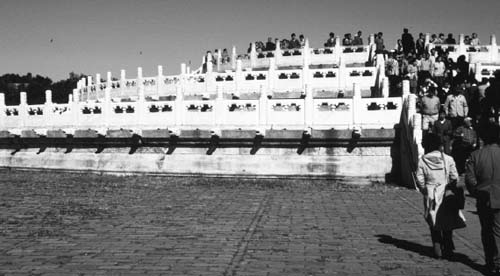Confucianism, the Literati, and Chinese Imperial TraditionsSigns and Symbols |
Are there symbolic dimensions in CIT sacred spaces? |
Imperial temples and altars have been highly symbolic down to the smallest detail. First, their placement in relation to each other and to the royal residence was critical. In imperial Beijing, for example, the Forbidden City stood at the center of the center of empire, which in turn was the center of the universe. Within the palace, arranged along its central north-south axis, is a succession of ceremonial halls. Beginning in the north and moving southward are the Palace of Earthly Peace, the Palace of Heavenly Brightness, the Hall of Protecting Harmony, the Hall of Middle Harmony, and the Hall of Supreme Harmony. On north-south and west-east axes stood pairs of sacred spaces balancing Yin and Yang forces. North of the Forbidden City was the Altar of Earth (Yin), square in shape. Its counterpart due south of that below the palace was the complex centered on the round Altar of Heaven (Yang) and its various related temple and other ritual buildings. West of the Forbidden City stood the Altar of the Moon (Yin) in its square enclosure, and to the east, the Altar of the Sun (Yang) in its round-edged enclosure. These four spaces are considerable distances (about two miles) from the palace. But immediately south of the palace, on either side of the north-south axis that leads out of the Forbidden City and into today’s Tian An Men Square, the Altar of Land and Grain stood to the west across from the imperial ancestral temple.
A good example of structural symbolism is the Altar of Land and Grain’s division into five sections, recalling both the directions and the five elements. Different-colored earth, brought from the corners and center of the empire, filled each section: yellow in the center, black in the north, red in the south, azure or green in the east, and white in the west. That structure and its companion ancestral temple were located between the Meridian Gate, which marks the southern extremity of the Forbidden City, and Tian An Men, the Gate of Heavenly Peace, which marks the northern perimeter of the square that bears its name.

The circular, three-tiered Altar of Heaven in the Temple of Heaven compound, Beijing.
